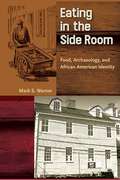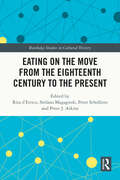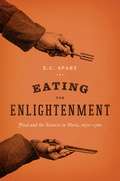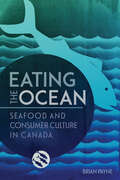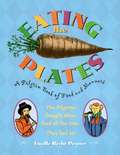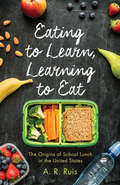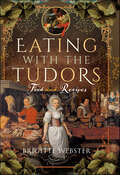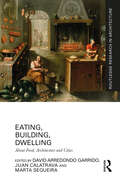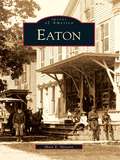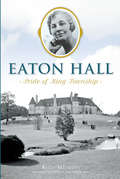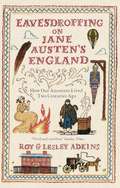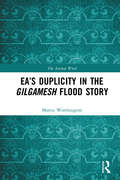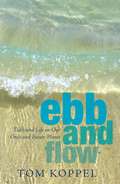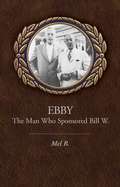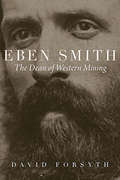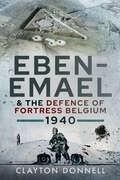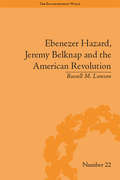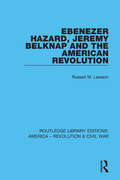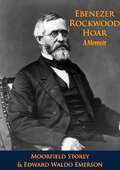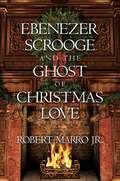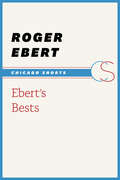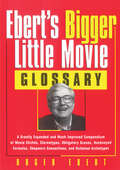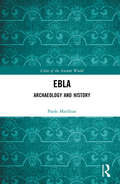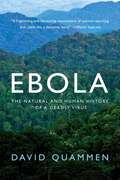- Table View
- List View
Eating in the Side Room: Food, Archaeology, and African American Identity (Cultural Heritage Studies)
by Mark S. WarnerAn archaeological study of African American foodways in nineteenth-century Annapolis In Eating in the Side Room, Mark Warner uses the archaeological data of food remains recovered from excavations in Annapolis, Maryland, and the Chesapeake to show how African Americans established identity in the face of pervasive racism and marginalization. By studying the meat purchasing habits of two African American families—the Maynards and the Burgesses—Warner skillfully demonstrates that while African Americans were actively participating in a growing mass consumer society, their food choices subtly yet unequivocally separated them from white society. The "side rooms" where the two families ate their meals not only satisfied their hunger but also their need to maintain autonomy from an oppressive culture. As a result, Warner claims, the independence that African Americans practiced during this time helped prepare their children and grandchildren to overcome persistent challenges of white oppression.Publication of the paperback edition made possible by a Sustaining the Humanities through the American Rescue Plan grant from the National Endowment for the Humanities.
Eating on the Move from the Eighteenth Century to the Present (Routledge Studies in Cultural History)
by Peter Scholliers Peter J. Atkins Stefano Magagnoli Rita D’ErricoThis book focuses on food and meals consumed during travel since the transport revolution and examines the ways in which the introduction of new forms of transport (propelled by team and petrol engines), not only affected the way people travel but also led to a transformation in the way we eat. Eating on board a train is different from eating on a ship, and the same is true for other forms of transport. Such differences are not simply a question of quality or variations of menu; a unique history has defined each of these different situations, a history which is still largely to be studied. This volume contains contributions from a mix of established food historians and young researchers. Social and economic history overlap with cultural history approaches and forays into the fields of linguistics and art, confirming that the field of food history, and more generally food studies, is by definition a field of transdisciplinary and border research. This volume will be of interest for scholars within the field of food history, food studies, and food culture, as well as social and cultural historians dealing with industrialization or social policy.
Eating the Enlightenment: Food and the Sciences in Paris, 1670–1760
by E.C. SparyEating the Enlightenment offers a new perspective on the history of food, looking at writings about cuisine, diet, and food chemistry as a key to larger debates over the state of the nation in Old Regime France. Embracing a wide range of authors and scientific or medical practitioners—from physicians and poets to philosophes and playwrights—E. C. Spary demonstrates how public discussions of eating and drinking were used to articulate concerns about the state of civilization versus that of nature, about the effects of consumption upon the identities of individuals and nations, and about the proper form and practice of scholarship. En route, Spary devotes extensive attention to the manufacture, trade, and eating of foods, focusing upon coffee and liqueurs in particular, and also considers controversies over specific issues such as the chemistry of digestion and the nature of alcohol. Familiar figures such as Fontenelle, Diderot, and Rousseau appear alongside little-known individuals from the margins of the world of letters: the draughts-playing café owner Charles Manoury, the “Turkish envoy” Soliman Aga, and the natural philosopher Jacques Gautier d’Agoty. Equally entertaining and enlightening, Eating the Enlightenment will be an original contribution to discussions of the dissemination of knowledge and the nature of scientific authority.
Eating the Ocean: Seafood and Consumer Culture in Canada (La collection Louis J. Robichaud/The Louis J. Robichaud Series)
by Brian PayneDuring the first half of the twentieth century, Canadian fisheries regularly produced more fish than markets could absorb, driving down profits and wages. To address this, both industry and government sought to stimulate domestic consumption via increased advertising. In Eating the Ocean Brian Payne explores how government-funded marketing called upon Canadian housewives to prepare more seafood meals to improve family health and aid an industry central to Canadian identity and heritage. The goal was first to make seafood a central element of a “wholesome” diet as a solution to a perceived nutritional crisis, and, second, to aid industry recovery and growth while decreasing Canadian fisheries’ dependency on foreign markets. But fishery managers and policymakers fundamentally miscalculated consumer demand, wrongly assuming that Canadians could and would eat more seafood. Fisheries continued to extract more fish than the environment and the market could sustain, and the collapse of the nation’s fisheries that we are now seeing has as much to do with failed assessments of market demand as it does with faulty extraction practices. Using internal communications between industry leaders and Ottawa bureaucrats, as well as advertising and promotional material published in the nation’s leading magazines, national and local newspapers, and radio programming, Eating the Ocean traces the flawed understanding of not only supply but demand, a misguided gamble that caused fisheries to become the most mismanaged resource economy in early-twentieth-century Canada.
Eating the Plates
by Lucille Recht PennerA Simon & Schuster eBookwith a ``Pilgrim Menu'' for readers to prepare with adult supervision. The illustrations include pen-and-ink drawings and lithographs that show period artifacts and various food items.
Eating to Learn, Learning to Eat: The Origins of School Lunch in the United States
by Andrew R. RuisIn Eating to Learn, Learning to Eat, historian A. R. Ruis explores the origins of American school meal initiatives to explain why it was (and, to some extent, has continued to be) so difficult to establish meal programs that satisfy the often competing interests of children, parents, schools, health authorities, politicians, and the food industry. Through careful studies of several key contexts and detailed analysis of the policies and politics that governed the creation of school meal programs, Ruis demonstrates how the early history of school meal program development helps us understand contemporary debates over changes to school lunch policies.
Eating with the Tudors: Food and Recipes
by Brigitte WebsterDive right into this extensive collection of authentic Tudor recipes, from suckling pigs to pax cakes! Eating with the Tudors is an extensive collection of authentic Tudor recipes that tell the story of a dramatically changing world in sixteenth-century England. This book highlights how religion, reformation and politics influenced what was served on a Tudor’s dining table from the very beginning of Henry VII’s reign to the final days of Elizabeth I’s rule. Discover interesting little food snippets from Tudor society, carefully researched from household account books, manuscripts, letters, wills, diaries and varied works by Tudor physicians, herbalists and chronologists. Find out about the Tudor’s obsession with food and uncover which key ingredients were the most popular choice. Rediscover old Tudor favorites that once again are being celebrated in trendy restaurants and learn about the new, exotic food that excited and those foods that failed to meet the Elizabethan expectations. Eating with the Tudors explains the whole concept of what a healthy balanced meal meant to the people of Tudor England and the significance and symbology of certain food and its availability throughout the year. Gain an insight into the world of Tudor food, its role to establish class, belonging and status and be tempted to re-create some iconic Tudor flavors and experience for yourself the many varied and delicious seasonal tastes that Tudor dishes have to offer. Spice up your culinary habits and step back in time to recreate a true Tudor feast by impressing your guests the Tudor way or prepare a New Year’s culinary gift fit for a Tudor monarch.
Eating, Building, Dwelling: About Food, Architecture and Cities (Routledge Research in Architecture)
by Marta Sequeira David Arredondo Garrido Juan CalatravaThe intricate relationship between food, city and architecture, spanning from ancient civilizations to the present, serves as a focal point for interdisciplinary discourse. This book delves into a diverse set of cases throughout history in which processes related to food significantly influenced architectural or urban designs.This book delineates three spatial levels — city, home and intermediate spaces — illuminating their dynamic interplay within the construct of a continually evolving “food space." Featuring 12 contributions from Mediterranean Europe, this publication explores historical legacies and contemporary challenges. Divided into urban-territorial and architectural scales, it offers nuanced insights into urban dynamics, domestic life and gastronomic tourism. Supported by a prestigious introductory study, this research advances a comprehensive understanding of food's role in shaping urban environments.Through the chapters of this book, those interested in cultural studies of food, urban history and architecture will be able to reflect on our relationship with food and its processes, and how it affects the way we live and design our cities and their architectures.
Eaton
by Mary E. MessereOnce touted as the "sparkling jewel" of Madison County because of its many scenic lakes and reservoirs built to feed the great Chenango Canal, the town and hamlet of Eaton have played an important role in the history of Madison County. From within its boundaries have come such luminaries as Emily Chubbuck Judson, early women's writer; humorist Melville Landon, better known to the world as Eli Perkins; and Samuel Chubbuck, inventor and the maker of the early telegraph equipment for Samuel Morse's telegraph. Eaton captures the history of this once-thriving community through pictures and stories of the Chenango Canal, early turnpikes, and steam engines made famous by Wood, Taber and Morse's Steam Engine Works. Many of these pictures are kept for the future in the Old Town of Eaton Museum, located in one of Eaton's oldest stone buildings.
Eaton Hall: Pride of King Township
by Steve Pellegrini Kelly MathewsIn 1901, Florence McCrea married into one of the most prosperous families in the Dominion of Canada, becoming Lady Eaton fourteen years later when her husband, John Craig Eaton, was knighted. Not long after the death of her husband, Lady Eaton retired from her home in Toronto to the seventy-two-room, Norman-style chateau she had built on their King City property. She named it Eaton Hall. The estate fueled the local economy and community, supported the Canadian World War II effort and established a firm place in the hearts and minds of the residents of King Township. Rediscover an enchanting and bygone age with the life and history of Lady Eaton and her grand Eaton Hall.
Eavesdropping on Hell: Historical Guide to Western Communications Intelligence and the Holocaust, 1939-1945 (Dover Military History, Weapons, Armor)
by Robert J. HanyokThis recent government publication investigates an area often overlooked by historians: the impact of the Holocaust on the Western powers' intelligence-gathering community. A guide for researchers rather than a narrative study, it explains the archival organization of wartime records accumulated by the U.S. Army's Signal Intelligence Service and Britain's Government Code and Cypher School. In addition, it summarizes Holocaust-related information intercepted during the war years and deals at length with the fascinating question of how information about the Holocaust first reached the West.The guide begins with brief summaries of the history of anti-Semitism in the West and early Nazi policies in Germany. An overview of the Allies' system of gathering communications intelligence follows, along with a list of American and British sources of cryptologic records. A concise review of communications intelligence notes items of particular relevance to the Holocaust's historical narrative, and the book concludes with observations on cryptology and the Holocaust. Numerous photographs illuminate the text.
Eavesdropping on Jane Austen's England: How our ancestors lived two centuries ago
by Lesley Adkins Roy AdkinsEavesdropping on Jane Austen's England explores the real England of Jane Austen's lifetime. It was a troubled period, with disturbing changes in industry and agriculture and a constant dread of invasion and revolution. The comfortable, tranquil country of her fiction is a complete contrast to the England in which she actually lived. From forced marriages and the sale of wives in marketplaces to boys and girls working down mines or as chimney sweeps, this enthralling social history reveals how our ancestors worked, played and struggled to survive. Taking in the horror of ghosts and witches, bull baiting, highwaymen and the stench of corpses swinging on roadside gibbets, this book is a must-read for anyone wanting to discover the genuine story of Jane Austen's England and the background to her novels.
Ea’s Duplicity in the Gilgamesh Flood Story (The Ancient Word)
by Martin WorthingtonThis volume opens up new perspectives on Babylonian and Assyrian literature, through the lens of a pivotal passage in the Gilgamesh Flood story. It shows how, using a nine-line message where not all was as it seemed, the god Ea inveigled humans into building the Ark. The volume argues that Ea used a ‘bitextual’ message: one which can be understood in different ways that sound the same. His message thus emerges as an ambivalent oracle in the tradition of ‘folktale prophecy’. The argument is supported by interlocking investigations of lexicography, divination, diet, figurines, social history, and religion. There are also extended discussions of Babylonian word play and ancient literary interpretation. Besides arguing for Ea’s duplicity, the book explores its implications – for narrative sophistication in Gilgamesh, for audiences and performance of the poem, and for the relation of the Gilgamesh Flood story to the versions in Atra-hasīs, the Hellenistic historian Berossos, and the Biblical Book of Genesis. Ea’s Duplicity in the Gilgamesh Flood Story will interest Assyriologists, Hebrew Bible scholars and Classicists, but also students and researchers in all areas concerned with Gilgamesh, word-play, oracles, and traditions about the Flood.
Ebb and Flow: Tides and Life on Our Once and Future Planet
by Tom KoppelEbb and Flow was named one of 2007’s "best science books" by Peter Calamai, science editor of the Toronto Star [Dec. 30, 2007]. He calls it a "wonderful resource book. Tom Koppel seems to have visited or read about every place with unusual tides and water currents, yet he wears this scholarship lightly." Tides have shaped our world. They have carved out shorelines, transformed early life on Earth, and altered the course of human civilization. Tides frustrated Alexander the Great and Julius Caesar, and aided General MacArthur. They govern the way our planet moves, provide us with an alternative source of energy, and may be aggravating global climate change. Drawing on science, history, and personal memories, Koppel’s fascinating book engages and enlightens, demonstrating that a subject we take for granted affects all our lives. He weaves together three grand narratives, exploring how tides impact coasts and marine life, how they have altered human history and development, and how science has striven to understand the surprisingly complex way in which tides actually work.
Ebby: The Man Who Sponsored Bill W.
by Mel B.This is both a fascinating history of the formative years of Alcoholics Anonymous, as well as the bitter-sweet tale of the troubled man Bill W. always referred to as "my sponsor."In 1934, Ebby Thatcher called an old drinking buddy to tell him about the happiness he was finding in sobriety. His friend's name was Bill Wilson, and this book is the story of their life-long friendship. It is both a fascinating history of the formative years of Alcoholics Anonymous, as well as the bitter-sweet tale of the troubled man Bill W. always referred to as "my sponsor.""Deeply informative and moving, a valuable contribution to the history of A.A. A 'must' reading for anyone interested in one of the more fascinating chapters in A.A.'s history."--Nell Wing, Retired A.A. Archivist and Bill Wilson's Secretary
Eben Smith: The Dean of Western Mining (Mining the American West)
by David ForsythDavid Forsyth recounts the life of Eben Smith, an integral but little-known figure in Colorado mining history. Smith was one of the many fortune seekers who traveled to California during the gold rush and one of the few who found what he sought. He moved to Colorado in 1860 with business partner Jerome Chaffee and over the next forty-six years was involved in mining in nearly every major camp in the state, from Central City to Cripple Creek, and in the development of mines such as the Bobtail, Little Jonny, and Victor. He was eulogized by the Denver Post and Denver Times as the “dean of mining in Colorado.” The mining teams Smith formed with Chaffee and with industrialist David Moffat were among the most successful and respected in Colorado, and many in the state held Smith in high regard. Yet despite the credit he received during his lifetime for establishing Colorado’s mining industry, Smith has not received much attention from historians, perhaps because he was content to leave public-facing duties to his partners while he concerned himself with managing mine operations. From Smith’s early years and his labor in the mines to his rise to prominence as an investor and developer, Forsyth shows how Smith used the mining and milling knowledge he acquired in California to become a leader in technological innovation in Colorado’s mining industry.
Eben-Emael and the Defence of Fortress Belgium, 1940
by Clayton DonnellIn the early morning of 10 May 1940, the sky literally fell on the heads of the defenders of Fort Eben-Emael, considered to be Belgium's most powerful fortress. This huge structure, with its powerful artillery and infantry weapons, was the key to the Meuse and Albert Canal defences. In the darkness of the pre-dawn, German DFS 230 gliders drifted silently over the southern Netherlands, landing one by one on top of Eben-Emael. Within minutes German Special Forces troops destroyed most of the fort’s weapons and observation capabilities. The following day, the garrison surrendered, and the door to Belgium and France was open. But, as Clayton Donnell relates in this perceptive and meticulously researched study, Eben-Emael was only one of the nineteen forts of the fortified positions of Liège and Namur attacked in May 1940. Three new and sixteen refurbished forts held out for several days, and fought to the death. The story he tells contradicts the common assumption that these static defences were rolled over or bypassed –powerless to resist the overwhelming force of the German combat engineer’s assaults, Stuka bombs and heavy artillery shells. In vivid detail he demonstrates that their importance in the 1940 campaign has been seriously under reported, and he gives clarity to some of the legends that have grown up around the capture of Eben-Emael itself.
Ebenezer Hazard, Jeremy Belknap and the American Revolution (The Enlightenment World #22)
by Russell M LawsonEbenezer Hazard – a classicist and natural scientist – became postmaster general in 1782. A prolific letter-writer, his favourite correspondent was Jeremy Belknap, a clergyman and historian. Their letters to each other provide an informative and insightful history of the time through everyday events.
Ebenezer Hazard, Jeremy Belknap and the American Revolution (The\enlightenment World Ser. #22)
by Russell M. LawsonOriginally published in 2011, this volume publishes the letters of Jeremy Belknap and Ebenezer Hazard. The letters encompassed twenty years, from 1779 to 1798, during a time when the United States was warring against England, establishing new governments, building a national identity, exploring the hinterland, and refining an American identity in prose and verse. The letters of Hazard and Belknap tell of an age when science and religion had not yet divorced due to irreconcilable differences, when the most profound philosophy nestled comfortably next to a childlike fascination with the remarkable. The two friends explored in their epistles the nature of love, death, and piety; the best way for humans to govern themselves; matters of religious and scientific truth and the best means to arrive at it; the methods and writing of history; human credulity; and the wonders of nature.
Ebenezer Rockwood Hoar; A Memoir
by Edward Waldo Emerson Moorfield StoreyFascinating biography of legal titan, noted abolitionist and diplomat Ebenezer Hoar.Ebenezer Hoar was admitted to the bar in 1835, and served the law at the bar and on the bench for more than a half century. He was a staunch Whig and a proponent of abolition of slavery. He served as Attorney General of the United States for more than a year during the first term of President Grant. He was also a member of the House of Representatives in 1872 and 1873 and an Associate Justice of the Supreme Judicial Court.
Ebenezer Scrooge and the Ghost of Christmas Love
by Robert Marro Jr.Ebenezer Scrooge and the Ghost of Christmas Love is the only sequel published to Charles Dickens&’ beloved Christmas classic that follows Ebenezer Scrooge&’s quest to rediscover true love after his harrowing Christmas Eve &‘Night of the Ghosts.&’ But even true love is not without its pitfalls.In a thrilling and poignant sequel to the World&’s most beloved Christmas tale of love and redemption, Charles Dickens&’s A Christmas Carol, a reformed Ebenezer Scrooge finds that his newfound mental and spiritual peace of mind cannot solve his remaining enduring problem: loneliness. Scrooge knows a pair of adopted kittens playfully named Julius and Caesar cannot make up for the love of a woman. By sheer coincidence, Scrooge discovers his estranged former fiancée Allyce Bainbridge is a widow whose husband died valiantly while serving with Her Majesty&’s Coldstream Guards in the Crimean War; however, Scrooge&’s socially awkward attempts to regain her trust are bitterly rebuffed. It takes another visit from the ghost of his former business partner, Jacob Marley, to tell Scrooge that only &“The Ghost of Christmas Love&” can unlock the chains of resentment binding Allyce&’s twice-broken heart. Marley further compounds Scrooge&’s dilemma by enigmatically telling him that this &“Ghost of Christmas Love&” will only manifest to Allyce if Scrooge is willing to make a sacrifice that all his wealth and gold cannot buy. Scrooge sets out to right the wrong from his past nagging at his soul breaking Allyce&’s heart. He enlists the unlikely but sincere help of Florence Nightingale and a cast of endearing characters, not all of whom are what they seem to be, in a satisfying story that answers the question: What happened to Ebenezer Scrooge after his Christmas Eve visit from the ghosts and his change of heart?
Ebert's Bests (Chicago Shorts)
by Roger EbertA treasury of year-by-year ten-best lists, plus personal reminiscences by the man whose name became synonymous with the movies. In Ebert&’s Bests, the iconic Roger Ebert takes us through the journey of how he became a film critic, from his days at a student-run cinema club to his rise as a television commentator in At the Movies and Siskel & Ebert. Recounting the influence of the French New Wave; his friendships with Werner Herzog and Martin Scorsese; and travels to Sweden and Rome to visit Ingrid Bergman and Federico Fellini, Ebert never loses sight of film as a key component of our cultural identity. In considering the ethics of film criticism—why we should take all film seriously, without prejudgment or condescension—he argues that film critics ought always to engage in open-minded dialogue with a movie. All this is accompanied by decades&’ worth of annual ten-best lists, which showcase Roger Ebert&’s recommendations—while at the same time reminding us that hearts and minds, and even rankings, are bound to change.
Ebert's Bigger Little Movie Glossary: A Greatly Expanded and Much Improved Compendium of Movie Clichés, Stereotypes, Obligatory Scenes, Hackneyed Formulas, ... Conventions, and Outdated Archetypes
by Roger EbertAn expanded glossary of movie clichés from the Pulitzer Prize–winning film critic. The popular film critic offers a compilation of witty and wise observations about the film lexicon, including “Fruit Cart,” a chase scene through an ethnic or foreign locale, or “The Non-Answering Pet,” referring to a dead pet in a horror movie.
Ebla: Archaeology and History (Cities of the Ancient World)
by Paolo MatthiaeIn Ebla , Paolo Matthiae presents the results of 47 years of excavations at this fascinating site, providing a detailed account of Ebla’s history and archaeology. Ebla grew from a small Early Bronze Age settlement into an important trading and political centre, which endured until its final destruction in c. 1600 BC . The destruction of its royal palace c. 2300 BC was particularly significant as it preserved the city’s rich archives, offering a wealth of information on its history, economy, religion, administration, and daily life. The discovery of Ebla is a pivotal moment in the history of archaeological investigations of the twentieth century, and this book is the result of all the excavation campaigns at Tell Mardikh- Ebla from 1964 until 2010, when field operations stopped due to the war in Syria. Available for the first time in English, Ebla offers a complete account of one of the largest pre-classical urban centres by its discoverer, making it an essential resource for students of Ancient Near Eastern archaeology and history.
Ebola: The Natural and Human History of a Deadly Virus
by David QuammenIn 1976 a deadly virus emerged from the Congo forest. As swiftly as it came, it disappeared, leaving no trace. Over the four decades since, Ebola has emerged sporadically, each time to devastating effect. It can kill up to 90 percent of its victims. In between these outbreaks, it is untraceable, hiding deep in the jungle. The search is on to find Ebola's elusive host animal. And until we find it, Ebola will continue to strike. Acclaimed science writer and explorer David Quammen first came near the virus while he was traveling in the jungles of Gabon, accompanied by local men whose village had been devastated by a recent outbreak. Here he tells the story of Ebola--its past, present, and its unknowable future. Extracted from Spillover by David Quammen, updated and with additional material.
